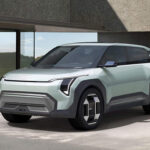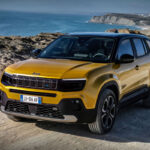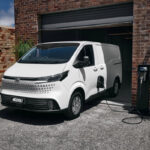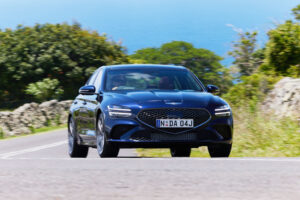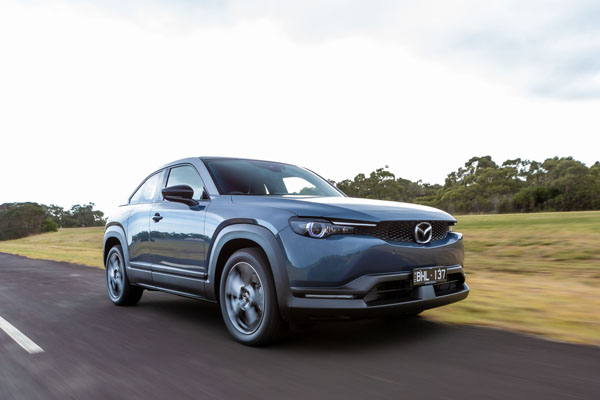
MX-30 EV is the first ever pure electric vehicle from Mazda. Launched here in April 2021 it’s a compact SUV, and joins the MX-30 MHEV mild-hybrid petrol/electric variant.
The name is a bit confusing given that previous cars with the MX prefix have been sporty coupes or convertibles, most notably the iconic MX-5 but when you look at the MX-30’s sleek profile it does start to make sense.
While the MX-30 MHEV comes in three variants, Evolve, Touring and Astina priced from $33,990 to $40,990, the EV is only available in the top-spec Astina at $65,490. On-road costs need to be added.
STYLING
MX-30 is built on the same platform as the CX-30 and shares many features. It’s slightly taller to cater for the batteries and, in line with its claim to an MX heritage, it does have a more fastback rear profile towards the rear.
Without an engine to cool there is no need for a grille at the front of electric cars. While competitors such as the Hyundai Kona and Kia Niro are easily distinguished by the closed-in front, Mazda MX-30 EV does come with a grille although it is much smaller than the large open-mounted design that’s been a feature across the Mazda range for some time.
One feature that is very different however – and one that attracted most attention during our test – are the rear doors. In another blast from the past Mazda has fitted what it calls ‘freestyle doors’, of the type that were last seen in the company’s RX-8 sports coupe.
The release catches for the rear doors are located behind the front seats which means that they can only be accessed when the front doors are open. Because they open rearwards, they do provide a large single opening entry. Despite this, access to the rear seats can be difficult especially in cramped parking areas. The front doors can be opened to almost 90 degrees which is useful but again care needs to be taken in tight areas.
POWERTRAIN
The MX-30 EV is powered by a 35.5 kWh lithium-ion battery. It’s a comparatively small battery when compared to its main rivals which equates to a lower drive range but, because it is lighter, it does make for sportier performance.
While others locate the charging points at the front of the vehicle those in the Mazda are at the more traditional location at the rear side where most fuel tank fillers are found.
There are two charging sockets the top one for single-phase AC charging up to 6.6 kW and the lower one a Type 2 plug for DC charging at up to 50 kW. Mazda Australia quotes a time of three hours to charge from 20 to 80 percent with AC and 36 minutes with DC.
INTERIOR
The overall interior design of the MX-30 is fresh and attractive with a functional layout to the dashboard.
Eco-friendly sustainable material is used including recycled plastic bottles on the upper door trims, Maztex vegan leatherette seats with 20 per cent recycled thread, and cork on the large storage space beneath the floating centre console as well as on flip caps on top of the two centre drink holders.
There are three screens, one behind the steering wheel with driver information; the typical infotainment screen at the top centre of the dash; and a touchscreen at the front of the floating centre console with climate control and seat heating.
The combination of the aforementioned rear seat access problems; limited leg and headroom including a large ‘transmission’ tunnel below the centre seats; lack of air vents and small windows almost turns the MX-30 into a 2 + 2. Again, following the RX-8 path.
Boot size is a disappointing 311 litres with the rear seats in place expanding only to 876 litres with the seatbacks folded. Additional space is taken up by the charging cable although it is in a velcro-bottomed bag that can be moved elsewhere.
SAFETY
The MX-30 EV Astina comes with a full suite of features including 10 airbags; blind spot monitoring; driver inattention alert; emergency lane keeping with road keep assist and blind spot assist; emergency stop signal; forward obstruction warning; high beam control; hill launch assist; lane departure warning; lane-keep assist system; radar cruise control with stop & go; front and rear parking sensors; rear cross traffic alert; reversing camera; smart brake support; rear crossing; turn-across traffic; traffic sign recognition; tyre pressure monitoring system; 360-degree view monitor; adaptive led headlamps; cruising & traffic support; driver inattention monitoring; and front cross traffic alert.
INFOTAINMENT
The 8.8-inch display screen is controlled through a large rotary dial on the centre console rather than being a touchscreen. There are short-cut buttons on the side as well as voice control. Apple CarPlay and Android Auto, both wired, are available. The screen layout is clear and user-friendly making for less driver distraction than from the typical touchscreen.
Unfortunately, the same logic hasn’t been applied to the 7-inch touchscreen in the central stack which is used to adjust the climate control and seat heating although there are physical buttons on either side as an alternative as well as a traditional small knob for audio on/off and volume control.
There’s also integrated satellite navigation, digital radio, two USB ports, 12-volt DC socket and a 12-speaker Bose sound system.
DRIVING
The MX-30 EV is sharp enough at take-off but without the torque steer that can affect some of its more powerful rivals.
Out on the open road the MX-30 EV comes alive with its light weight and low centre of gravity – courtesy of the size and location of the battery – providing driving dynamics that none of the EVs that we’ve driven previously can match.
Handling is accurate and smooth with the steering wheel providing the right amount of feedback.
Cornering is accurate enough, but this is not a sports sedan, and is certainly not planned to be one.
Like many electric vehicles Mazda MX-30 EV uses an artificial engine sound that’s piped into the cabin through the audio system. Opinion is divided between those who like the sporty sound it produces and others who love the quieter running which electric cars provide. For those in the latter category, it can be turned off but only through a complex combination of the brake pedal and multiple clicks of the left and right paddle shifters.
A Mazda dealer should be able to provide the details, otherwise go into Google.
As with all EVs, the MX-30 does have brake regeneration to charge its battery. While the level can be adjusted through steering wheel mounted paddles it doesn’t provide the single pedal driving feature that we’ve enjoyed in other models. While it will slow the car down steadily, even with the re-gen at its maximum the brakes need to be applied to bring it to a full stop.
SUMMING UP
The crucial issues with electric vehicles are price and range. For volume sales to occur, the first needs to come down and the second to go up. At $65,490 the MX-30 EV Astina is around the same price as two of its similarly-equipped competitors, the Hyundai Kona Highlander Extended Range ($64,000) and Kia Niro Sport ($65,990).
However, it lags well behind their 450-plus kilometre range and that effectively limits potential sales to city dwellers which is a great pity because the Mazda’s driving dynamics are so well-suited to rural conditions.
Having said that, Mazda has been sitting in second place behind Toyota in overall sales for a number of years. With the popularity of electric vehicles sure to rise in future, brand loyalty will no doubt attract many of those looking to make an environmental statement both through the car’s zero emissions but also its use of recycled components.
AT A GLANCE
Mazda MX-30 Astina EV: $65,490
Note: This price does not include government or dealer delivery charges. Contact your local Mazda dealer for drive-away prices.
SPECIFICATIONS (Mazda MX-30 E35 Astina electric five-door SUV)
POWERTRAIN:
Maximum Power: 107 kW @ 4000 rpm
Maximum Torque: 271 Nm
Maximum Range: (ADR 81/02) 224 km
CO2 Emissions: Zero
DRIVELINE: Single-speed automatic
DIMENSIONS, WEIGHT AND CAPACITIES:
Length: 4395 mm
Wheelbase: 2655 mm
Width: 1848 mm
Height: 1555 mm
Turning Circle: 11.4 metres
Kerb Mass: 1654 kg
Fuel Tank Capacity: NA
BRAKES:
Front: Ventilated disc
Rear: Solid disc
STANDARD WARRANTY:
Five years / unlimited kilometres
RATINGS
Looks: 8/10
Performance: 8/10
Safety: 8/10
Range: 6/10
Emissions: 10/10
Practicality: 8/10
Comfort: 7/10
Tech: 8.5/10
Value: 5/10
Overall: 7.6/10






